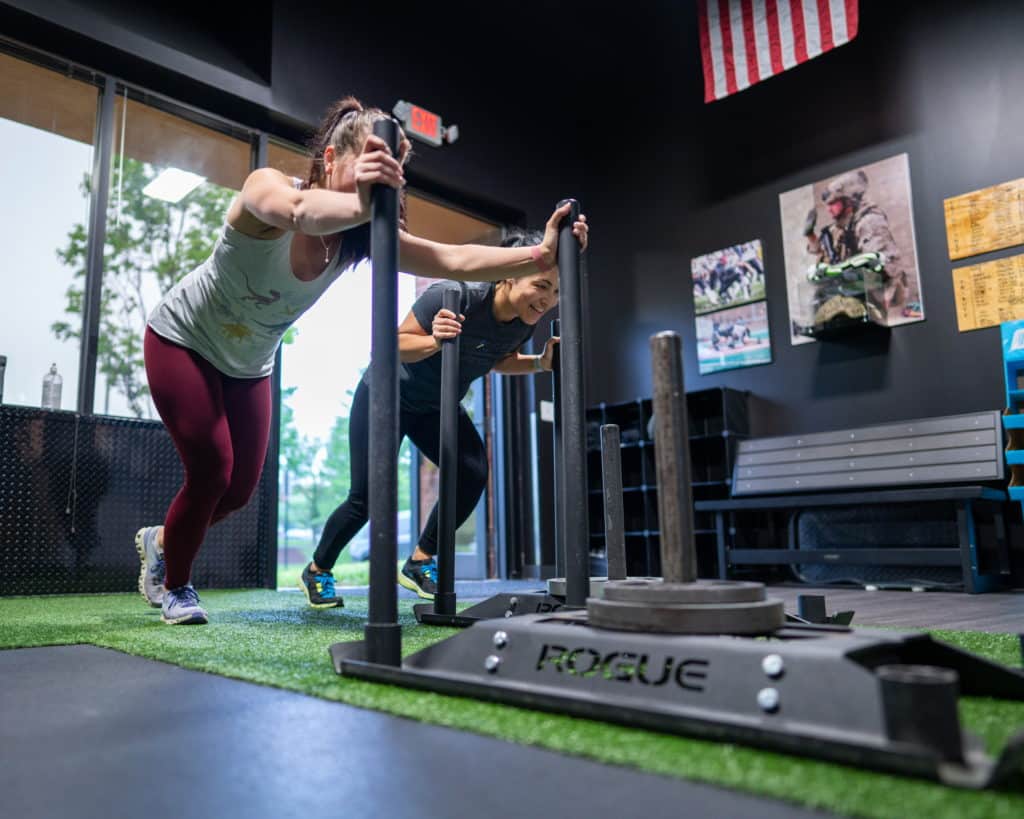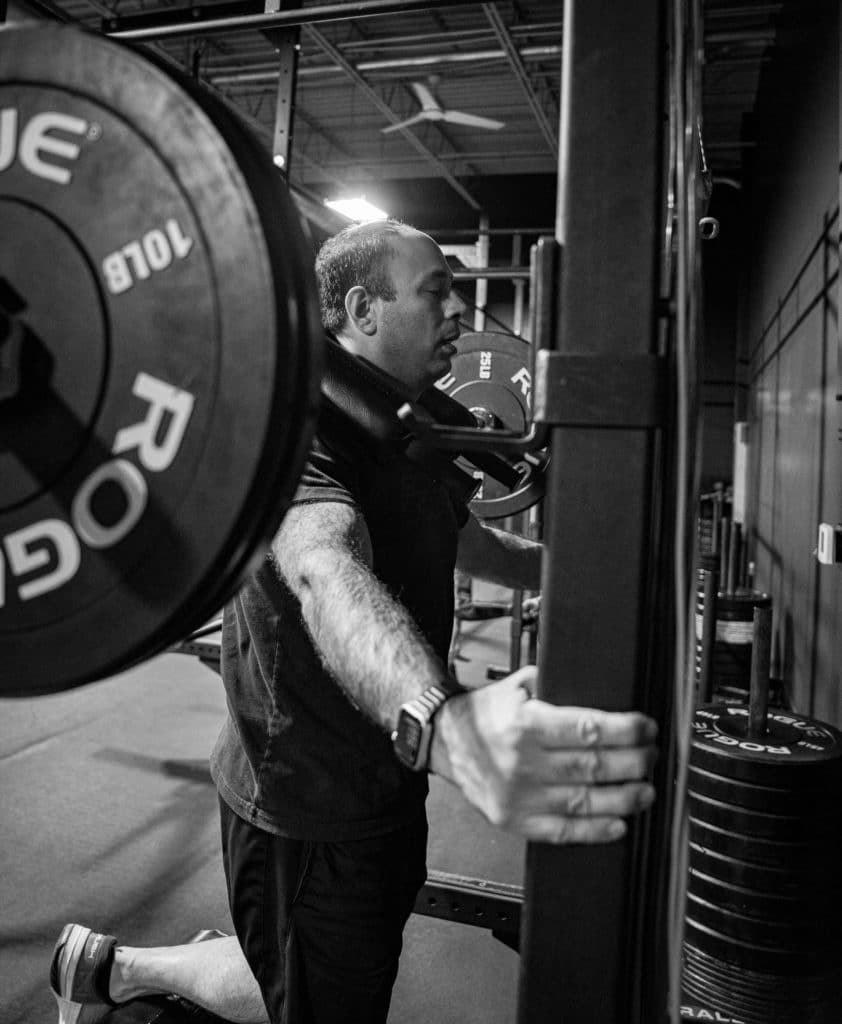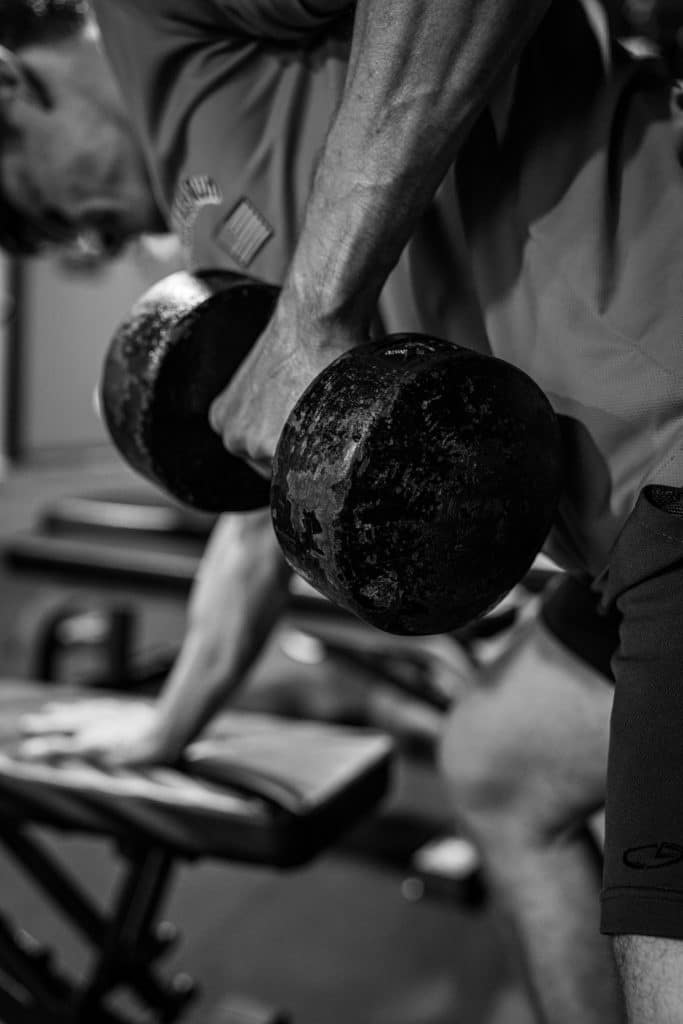Good training requires planning. It isn’t just some arbitrary process of doing exercise. It’s the culmination of doing the right exercises, and the right types of exercise, in the right sequence. That is how you build true and lasting fitness.
The problem is, most gyms and trainers don’t know how to plan effective year-round training. They do their clients a huge disservice. That, sports fans, is where we are different.
We meticulously plan our training at Beyond Strength. And we’re giving you a look behind the curtain to understand the process.
We’ll teach you what goes into developing a year-long training plan and we’ll outline the progression of our training “blocks.”
First, we start at the end of the training year and work backward.
Starting with the end in Mind: Organizing the Training Year based on the Perfect Scenario
I’m certain you’ve heard the cliched advice, start with the end in mind.
Starting with the end mind broadens perspective on the goal. It offers clarity. Once clear, it’s easier to plan the steps, actions, and outcomes that achieve the desired end. The process motivates thought. We must consider what resources we need to execute the plan and how to allocate those resources. Then, having the end in mind, the plan in place, and the actions executed, you have all the means you need to evaluate your progress. Is the plan working or not? If not, we have information that guides us toward the necessary changes. Program design based on the year-round perfect scenario works the same way.
Our year-round training plan starts with a simple thought experiment based on the perfect scenario.
It goes like this:
If we could plan the perfect year-round training scenario, what would it look like? What goals are we working to accomplish? What training modalities would we use and when would we use them? How many training blocks and training phases would we use? What would the results be?
The answers to these questions provide us with the raw materials with which to think. Then, we take those raw materials and develop a perfect scenario program outline that encompasses the entire training year.

The outline includes the big-ticket items: training blocks (consisting of three training phases), training phases (each being a four-week training program), and modalities used sequentially in each phase. Each block is designed to accomplish a specific goal that is congruent with our overall training goal—improving all aspects of general work capacity.
Let’s break down each aspect that contributes to organizing the year-round training plan.
Training Blocks
In our system, a training block is a collection of three, four-week training phases completed in series. Each training block has a specific goal. For example, max strength and aerobic power, strength and aerobic capacity, or strength and hypertrophy. While each block has a specific goal, all physical qualities are trained. Some get developmental volume while others get maintenance volume. This is called concurrent periodization.
Each of the blocks are three months, or 12 weeks, because that’s how long it takes to elicit most training adaptations.
Training Phases
A phase is a 4-week program. It consists of daily and weekly exercise selections, volume prescriptions, and organization of training modalities by the day. Since there are three to four phases in a training block, we progressively sequence them to meet the overall goal of the training block.
The Training Week
Each phase consists of four training weeks. And those weeks are organized via the neural-metabolic continuum.
This means that the most neurologically demanding training—heavy strength and power training—is done at the beginning of the week. As the week progresses, training is more metabolically demanding. We organize this way because metabolic stress limits access to neurological ouput. Meaning that if you frontloaded the week with metabolic stress, like high-intensity conditioning, the accumulated fatigue limits your access to your strength and power. You wouldn’t be able to train strength and power with as much focus and intensity, limiting progress. There are occasions to break this rule, but not many.
Each training week has a purpose.

Week one is Base Week. It’s the first week of a new program. Clients get their first dose of new exercises, new training modalities, and new loading strategies. Intensity is relatively low since they are orienting to all of the newness.
Week two is Train Week. Volume remains constant from Base Week, but relative intensity increases because clients are accustomed to the training.
Week three is PR (personal record) and Go Home Week. We’re not talking about lifetime PRs. We’re talking the most intensity during the given phase. Volume is decreased as the intensity increases this week.
Week four is Reach Week. Volume is increased above the levels of Base and Train Week while intensity is reduced to about the Base Week level.
Now, I don’t want to create confusion about exercise selection and exercise changes—especially after the explanation of Base Week’s purpose. We don’t bombard Beyond Strength members with totally new exercises all the time. Yes, we do introduce new exercises when it makes sense to reach the training goal, and for a little fun. But mostly we stick with a handful of staples.
Constantly changing exercises means that people are constantly learning new shit. And when folks are constantly learning, they can’t train as hard. So, we created a staple exercise menu that builds on coinciding skills, helping our members to consistently train harder.
We train the basics hard and with intelligent structure. That’s how we get results.
The Training Day
The training week is, of course, a collection of training days. Each training day includes a warm-up, the main workout, and a cool-down. The composition of the training day depends on which physical quality we’re training. The main qualities we train are movement capacity, power, strength, aerobic capacity, and aerobic power. While movement capacity is trained during every workout, the other qualities get their own training days.
Training Block Yearly Progression
Now that you understand the breakdown of all the units that make up the year-long training plan, let’s zoom back out and chat about the training block progression. We sequence training blocks in a specific way so that we train for the right things at the right times. This isn’t willy-nilly organization or arbitrary structure. It’s necessary to develop some physical qualities before you can take full advantage of training for others.
Remember that the main training goal at Beyond Strength is to improve general work capacity. It’s the ability to utilize all of your physical abilities (power, strength, conditioning) over time. General work capacity is the foundation of an active life, and it lays the foundation for any specific work capacity you’d like to develop. For example, if you want to launch yourself into running trail ultramarathons, it’s best to start by having the aerobic development and relative strength that comes from developing general work capacity. Each Beyond Strength training block focuses on an aspect of work capacity.
Let’s dive into the blocks, the qualities they develop, and a little of the “why” behind them.
Block 1: Strength Capacity and Aerobic Capacity
We begin the training year with 12 weeks of capacity training. This choice is guided by one of our main training principles: capacity comes before power. Why?

Capacity training develops the raw materials of the systems. Aerobic capacity training, the focus of our Endurance classes, improves cardiac output (amount of blood pumped out with each beat), increases capillary density, increases mitochondrial density, and improves autonomic nervous system tone. This is important for a couple of reasons.
First, if you want a biological system to work faster, it must first have the necessary components to increase its work rate. We need more blood per stroke before we ask the heart to work faster. We need more mitochodria before we ask them to metabolzie fuel faster. Without these raw materials, we can’t ask the body to work harder and expect it to adapt.
Second, the aerobic system is the recovery system. All of your recovery from exercise, be it between sets, between exercises, or between training days, is sponsored by aerobic metabolism. This is due to its delivery of oxygen and nutrients. As well as its effect on the autonomic nervous system. Aerobic capacity training helps the body shift from being sympathetic (fight or flight) to parasympathetic (rest and digest). And it helps the body to flip that switch more quickly and more efficiently. Meaning that you recover faster from exercise. So, if we want to get the most out of our more intense training, we must build the system to recover from that training.
Strength capacity training does the same thing in a slightly different way.
It builds our tissue tolerance so that our muscles, tendons, and ligaments are better prepared for heavier weights. Strength capacity training also offers lots of practice with our key movements, improving your skill before you attempt to lift heavier and heavier weights.
Block 2: Max Strength and Aerobic Power
After we build the systems, we train them to work faster.
The second training block of the year is designed to increase the rate of our neuromuscular and metabolic output. We get stronger and more powerful. We train to sustain harder conditioning efforts. This carries over into everyday life because we’re able to work hard without fatiguing. A great example of this is an uphill climb while hiking. If you’re body isn’t used to producing energy aerobically at higher intensities, it will recruit more of your anaerobic energy system. The result is your muscles burn way faster and way worse; and it takes you way longer to get up that hill.

During this phase we increase the volume of heavy lifting during Strength classes, and we shift our focus to aerobic power conditioning during Vigor classes. Heavy lifting trains our neuromuscular system to generate more force and to generate it more quickly. Aerobic power trains our body to generate energy at a faster rate. The training is, well, hard. It pushes the heart rate up to anaerobic threshold and holds it there for an extended period.
This builds serious fitness and it’s worth the effort.
We still include Endurance class in this training block. But we reduce its volume to maintenance.
You’ve efficiently layered your fitness by the end of Block 2. You have the capacity to sustain efforts and the power to work hard.
Block 3: Live and Maintain
The weather starts getting nice at about the end of Block 2. And we’ve just spent 24 weeks working with developmental training volumes. It’s time for a little reprieve. Now, that’s not to say that we stop training. But we shift toward maintenance volumes of all of the qualities we train. And there are two, great reasons why.
First, we’d burn out, mentally and physically, if we kept hammering on with developmental training volumes. Our bodies and minds need a break.
Second, Block 3 starts in late spring and runs through the summer. It’s nice outside. We’re doing more hiking, kayaking, running, and living outside. We need to make room in our overall activity volume to be outside doing fun shit. That’s why we train, right? But we also can’t lose what we’ve built.

During this block, we do two to three maintenance strength sessions (Strength classes), an aerobic power maintenance session (Vigor class), and an aerobic capacity maintenance session (Endurance class).
Block 4: Strength and Hypertrophy
Block 4 begins at the end of the summer and carries on through the fall until the end of the year. It’s the time of year when we’re typically eating more calories, so why not put them to good use building muscle? Muscle mass is also necessary for longevity and for continuing to improve our relative strength. Even though our goal isn’t to be jacked bodybuilders, we still need dedicated hypertrophy training.

During this block, we increase the resistance training volume to build strength and muscle. Our conditioning is put into maintenance volume, so we don’t lose what we’ve built throughout the year. You’ll see four Strength Classes per week, and a hybrid of Vigor and Endurance classes depending on the training phase.
This year-long training plan develops well-rounded, general work capacity. It trains all of the physical abilities we need to do the things we love and perform how we want to perform while doing them. And it helps us to go on doing the things we love over the long-term.
What if You Don’t Start at the Beginning of the Year?
Don’t let the FOMO hit you in the chest. We organize our plan based on the perfect scenario, but we know that life is far from perfect.
It’s okay if you don’t start during the first training block. It’s also okay if you start in the middle of a training block. Why? We test you to learn exactly what you need to do.
The outcome of testing tells us which classes you should attend and how you should work during those classes. That means we can tailor your training to meet you where you’re at and give you what you need. So, even if you start during the max strength and aerobic power block, and you need more capacity training, we’ll coach you to perform each session in a way that will get you what you need.
Then, as you make gains, you’ll reap all the benefits of a progressive, year-long plan.
You might also like:
- WHY WE TEST AR BEYOND STRENGTH
- TIPS FOR COMPETING WITH YOURSELF IN THE GYM
- HOW TO SET GOALS FOR 2023
- HOW MANY REPS SHOULD YOU DO? (Spoiler alert, it matters in more ways than you think)
- HOW TO KEEP EXERCISING WHILE TRAVELING
- LET’S SEE HOW GREAT I CAN DO THIS
- HOW TO PROGRESS YOUR WEIGHTS DURING A STRENGTH PROGRAM
- HOW TO RECOVER FROM YOUR WORKOUTS
- WHICH TYPE OF CONDITIONING IS BEST FOR FAT LOSS
- FITNESS: THE INFINITE GAME
- HOW TO BUILD STRENGTH AND ENDURANCE AT THE SAME TIME
